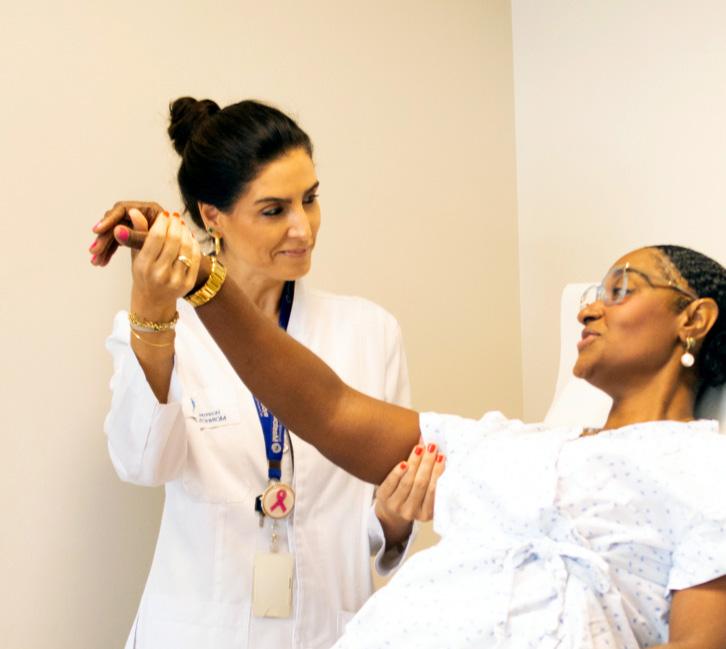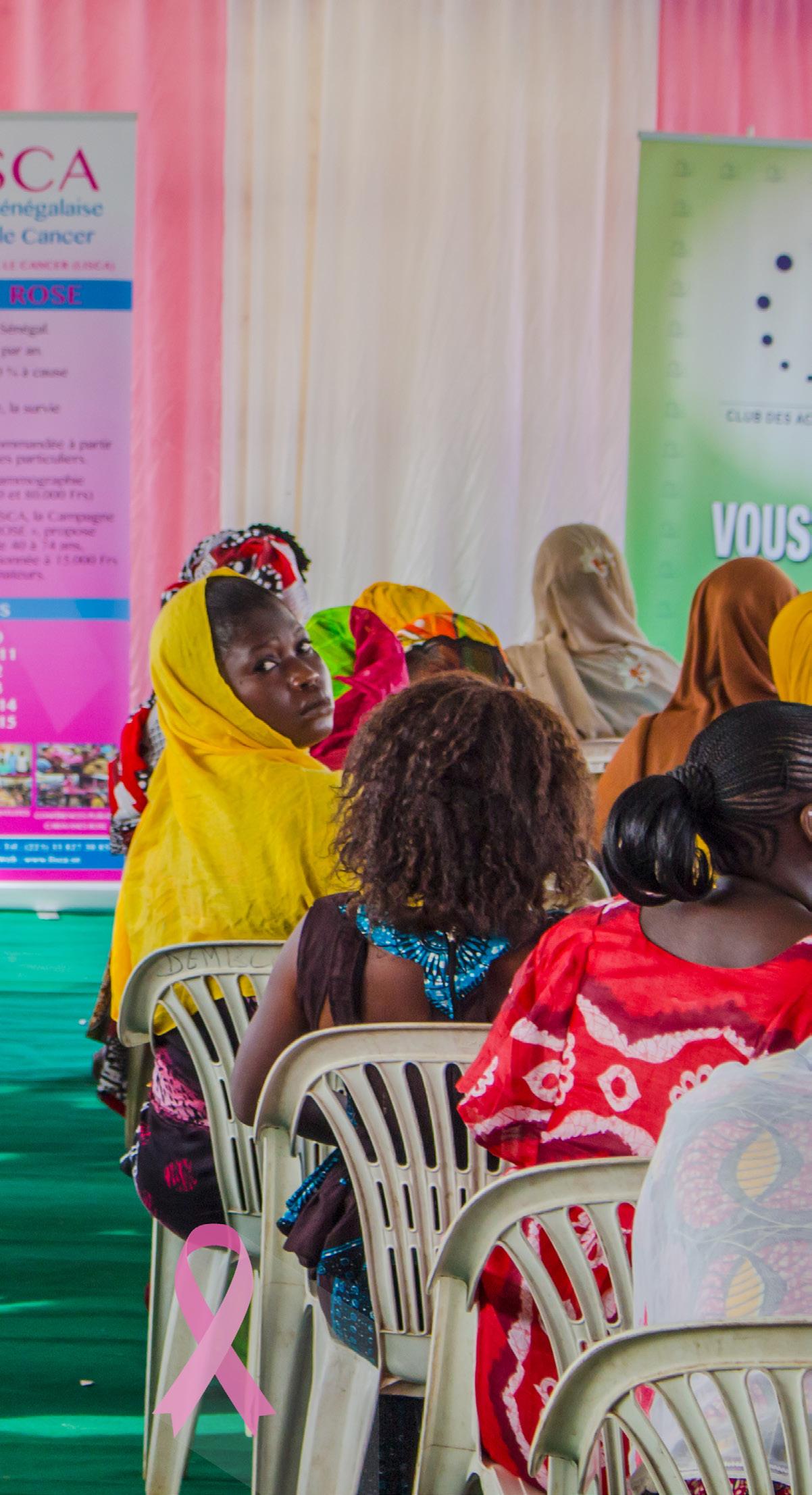Strengthening equitable access to breast cancer care through national health policies
Why is breast cancer a health priority?
Breast cancer is not only a health issue, it is an urgent global crisis, as well as a matter of gender equity, human rights and economic justice.
With approximately 2.3 million new cases and 670,000 deaths reported in 2022 alone, it stands as the most common cancer diagnosed among women worldwide. Globally 1 in 20 women will be diagnosed with breast cancer in their lifetime, and 1 in 70 will die from the disease.
Projections paint a concerning picture for the future: by 2050, annual breast cancer diagnoses could surge to 3.2 million, resulting in 1.1 million deaths each year if current trends continue.1 The rising incidence is fueled not only by demographic shifts, such as population growth and ageing, but also by increasing exposure to various risk factors, such as obesity, physical inactivity, alcohol consumption and reproductive changes.
Individuals from low and middle income countries (LMICs) experience disproportionately higher mortality: five-year survival rates in high income countries (HICs)
exceed 90%, for example in the USA, compared with 66% in India and 40% in South Africa. Women who are part of vulnerable and under-resourced groups are subject to higher mortality in all countries. Disparities in access to early detection, diagnosis, and treatment are a result of broader systemic inequities and are influenced by an interplay of factors, including access to healthcare, a patient’s biological characteristics, and social determinants of health. Addressing these inequities is a moral and public health imperative, central to achieving the Sustainable Development Goals (SDGs).2
With the projected rise in cases and deaths, the international community faces an urgent challenge requiring coordinated action to ensure millions of lives are not lost to a disease that is increasingly preventable and treatable.
In response to this challenge, WHO launched the Global Breast Cancer Initiative (GBCI) in 2021, offering countries a roadmap for integrated and equitable breast cancer strategies to reduce mortality, saving 2.5 million lives by 2040. The initiative is anchored on three pillars: health promotion for early detection, timely breast cancer diagnosis, and comprehensive breast cancer management.5
Pillars
The financial case for breast cancer
Investing in breast cancer is an economic opportunity rather than a financial burden.
Implementing WHO best buys on breast cancer has demonstrated substantial cost-effectiveness and potential cost savings. WHO EMRO reports that investment in early diagnosis and comprehensive treatment of breast cancer could provide a return of US$ 6.40 to US$ 7.80 for every US$ 1.00 invested.3,4
What’s needed: Priority actions for breast cancer control
Strengthening early detection through integrated
health promotion
Prioritising and funding early detection within national cancer control plans is critical to ensure breast cancer is diagnosed at an early stage and to significantly reduce the long-term burden of breast cancer.
Early detection of breast cancer is crucial to improve survival rates in all settings. The GBCI outlines a target of 60% of invasive breast cancer cases diagnosed at stage 1 or 2. It requires the development of health promotion interventions to improve breast health knowledge amongst women and their communities, as well as training health care professionals to identify the early signs of the disease.
Yet, many countries lack national programmes that effectively integrate early detection into primary healthcare systems. Without effective early detection programmes, women are too often diagnosed at late stages, which drastically reduces treatment effectiveness and significantly increases costs. This situation is further compounded by low public awareness, stigma, and cultural, financial, and logistical barriers that hinder timely care-seeking behaviour.
Breast health education reduces stigma and equips women and communities with knowledge on riskreduction behaviours, signs and symptoms of breast cancer, importance of breast self-examination, and encourages early presentation to health services (or access to screening programmes, when available). Since 21% of global deaths from breast cancer can be attributed to alcohol, post-menopausal overweight and obesity, and physical inactivity6, prevention of breast cancer is an important component of breast health education.
Education efforts should be culturally sensitive, community-based, and embedded into existing health programmes, including maternal and reproductive health services, or broader NCD programmes.
Early detection: Early diagnosis vs. screening for breast cancer
Early detection is the overarching goal of finding breast cancer at an early stage, either through early diagnosis programmes (which ensures systematic and timely evaluation of symptomatic women) or through populationbased screening of asymptomatic populations. Screening should only be implemented where health system capacity can guarantee quality diagnosis and treatment, hence early diagnosis is the recommended approach for most LMIC settings.
In parallel to raising awareness, training community and primary-level health workers to identify the symptoms and refer appropriately is key to bridging the gap between awareness and access to care. In low-resource settings, clinical breast examination (CBE) offers an effective and evidence-based approach for detecting breast cancer in both asymptomatic and symptomatic cases. It should be implemented by providing training to primary level practitioners as well as with clear referral pathways and timely diagnostic follow-up. In settings where early diagnosis programmes are in place and well implemented, health infrastructure requirements and financial needs are met, countries can consider implementing populationwide screening programmes, and also propose genetic counselling, and testing, for those at high risk as a preventative measure.
Expanding access to timely and accurate diagnosis
Timely and accurate diagnosis can significantly improve survival and treatment outcomes and is paramount to deliver positive treatment outcomes.
The second target of GBCI is for evaluation, imaging, tissue sampling, and pathology reporting to be completed within 60 days of presentation, with research indicating that a longer timeframe can negatively impact survival rates.7 Additionally, accurate diagnosis, including imaging, biopsy, and pathology, is critical to determine the cancer type, stage, and biomarker status, which then guides appropriate and personalised treatment decisions. However, limited diagnostic infrastructure, workforce shortages, weak referral systems, and financial and geographic barriers - especially outside urban centres - hinder timely access to diagnosis for many individuals.
Addressing these challenges requires a multifaceted approach including investment in diagnostic capacity, in workforce training and retention, and the decentralisation of diagnostic services where feasible and appropriate. Establishing centres that can provide high-quality, timely diagnostic testing as well as patient-centred navigation services can be considered to improve access in rural and underserved areas. Effective patient navigation can reduce delays throughout the patient pathway, from patient presentation to diagnosis within the 60-day window, and from diagnosis to treatment within a recommended further 30 days.
Additionally, removing financial barriers by including essential diagnostics within universal health coverage schemes is vital to ensure equitable access.
Ensuring access to comprehensive treatment and care
Effective breast cancer treatment requires a coordinated, multidisciplinary approach that ensures timely access to surgery, systemic therapy, radiotherapy, supportive8 and palliative care, tailored to a personalised treatment plan.
The GBCI sets a target of 80% of patients diagnosed with breast cancer completing their prescribed treatment without abandonment. In many countries, however, poor healthcare infrastructure, limited specialist availability, fragmented care pathways and financial barriers continue to restrict access to cancer services. Limited radiotherapy services, particularly in LMICs, represents a significant global health inequity, impeding access to breast-conserving surgery and treatment for advanced breast cancer cases.
These challenges are particularly acute for individuals in underserved areas, and for those with advanced disease.
To address these gaps, patients need to be able to obtain treatment free of charge, health infrastructure must be upgraded to deliver multimodality treatment, oncology specialists need to be trained and retained, and systems to guide patients through complex care journeys should be established.
Patient navigation for breast cancer
Patient navigation refers to a health system intervention that supports individuals, families and communities in overcoming barriers across the cancer care continuum, by providing timely guidance, information, and coordination of services. Its goal is to guide individuals through complex cancer care pathways to ensure that every patient, regardless of background or circumstance, can access early detection, diagnosis, treatment, palliative care and survivorship services in an equitable and efficient manner.
WHO recommends integrating tailored navigation programmes within national cancer frameworks backed by dedicated training, budget, and evaluation mechanisms to ensure no one is lost to system complexity.
Beyond medical treatment, the financial and psychosocial needs of patients and caregivers must be fully recognised in cancer policies. The burden of disease often extends to loss of income, fertility challenges, and mental health concerns, all of which are compounded by stigma. The lack of childcare and the costs of transport to treatment facilities are additional barriers commonly faced by patients and their families. These pressures can cause significant distress and undermine adherence to treatment. Ensuring that policies address these realities, and that individuals with advanced-stage disease have guaranteed access to integrated palliative care, effective pain relief, and comprehensive supportive services, is a matter of fundamental human rights.
Integrating psychosocial, financial, and clinical care services, together with accessible information on treatment options, must be designed with input from people with lived experience of breast cancer. The involvement of those with lived experience is critical throughout the patient pathway and more widely within health systems as it supports more responsive and equitable systems, and helps to improve quality of life.
Call to action
Governments and advocates must urgently make breast cancer a national health priority — integrating early detection, timely diagnosis, and equitable treatment to save lives, advance women’s rights and strengthen health systems for the future.
Policy recommendations across the health system components
To effectively address breast cancer, actions across all aspects of the health system must be prioritised and supported by broader health system investments.
This includes strengthening health information systems to reduce delays and ensure timely access to care, establishing robust populationbased cancer registries, and monitoring service coverage to identify gaps and guide evidence-based improvements. Standardised referral protocols are essential to streamline care pathways and support diagnosis and treatment adherence. Implementation research, carried out in partnership with other actors, such as people with a lived experience of cancer, academia and civil society, can test context-appropriate models and generate local data to inform service delivery. Equally important is ensuring that people with lived experience help inform programme design, fostering responsive, inclusive, and equitable breast cancer services, and are integrated into policy oversight mechanisms.
The following table summarises critical policy actions across all health system domains, with corresponding enabling factors to monitor progress and ensure accountability.
1
≥60% of invasive
BC diagnosed at early stage (I–II)
2
≤60 days between initial presentation and complete diagnosis 3
≥80% of breast cancer patients completing recommended treatment
Health system component Policy asks Enabling factors
Design and implement national early detection programmes that are tailored to country context and integrated into relevant services, such as primary health care, maternal health or broader non-communicable disease programmes.
Promote community awareness and culturally appropriate education programmes to increase knowledge of breast cancer prevention, signs and reduced stigma (including on advanced cancer) engaging relevant stakeholders such as civil society, community leaders, media, schools and workplaces.
Strengthen diagnostic infrastructure, including imaging, biopsy and pathology services to improve accessibility.
→ National early detection programme on breast cancer (either early diagnosis, either screening)9
→ National early detection programme integrated into other NCD programmes
→ National early detection guidelines for breast cancer
→ Community awareness campaigns and breast health educational programmes
system component Policy asks
Develop and implement national referral protocols and systems for breast cancer across the healthcare system, addressing barriers in the patient pathway.
→ Referral pathways integrated into electronic health records and cancer registries
Service delivery
Ensure that all breast cancer patients have access to multidisciplinary treatment with patient cases discussed in multidisciplinary tumour boards (MTBs), and supported by upgraded surgical and radiotherapy infrastructure as needed.
→ National diagnostic guidelines for breast cancer
→ General availably of imaging services in the public sector
→ General availability of pathology services in the public sector, with ability to test for ER, PR and HER210, 11
→ National breast cancer treatment guideline
→ General availability of breast cancer surgery in the public sector4
→ General availability of systemic therapy (endocrine, chemotherapy, HER2-targeted) available in the public sector4, 12
→ General availability of radiotherapy in the public sector4
→ Patient cases are discussed in MTBs
Implement patient navigation, care coordination and supportive care services throughout the patient pathway, tailored to individual needs to reduce diagnostic delays, loss to follow-up, and increase treatment adherence, leveraging all actors including civil society to enhance available services.
Train health care workers at the primary care level in clinical breast examination and referral protocols, and on signs and symptoms (including advanced stages), enhancing the capacity for identification of symptomatic cases.
Train and retain specialised workforce in oncology, pathology, imaging, surgery, nursing, psychosocial support and survivorship for breast cancer.
→ Patient navigation programme
→ Patient reported outcomes are monitored to ensure patient-centred care
→ Supportive care integrated in cancer services, since planning of treatment
→ Oncology workforce development programme
→ Training programme for health professionals on CBE and patient navigation
Health information systems
Include key breast cancer indicators within data systems to track progress on early detection, treatment outcomes, and patient experience to inform planning of policies.
→ Operational population-based cancer registry
→ The registry includes stage at diagnosis, treatment initiation and completion, survival and recurrence (including metastatic disease)
→ Integrate breast cancer indicators in national data systems
→ Ability to track progress towards achieving 6060-80 targets
Include WHO-recommended breast cancer treatments, supportive and palliative care medicines, in national essential medicines lists, including morphine, anti-emetics, hormonal therapies, targeted therapy and chemotherapy, and ensure reliable access.
Access to medicines & technologies
Include diagnostic technologies into the national essential diagnostic list, including breast ultrasound, mammography, core needle biopsy, histopathology, and immunohistochemistry (ER, PR, HER2).
Allocate dedicated funding in national benefit packages under universal health coverage particularly for early detection, diagnosis (imaging, biopsy and pathology), treatment, supportive and palliative care.
→ National essential medicines list includes breast cancer medicines, supportive and palliative care medicines
Leadership & governance
NCCPs include evidence-based breast cancer control strategies adapted to the national context, covering the full continuum (early detection, diagnosis, treatment, supportive and palliative care, survivorship), including reference to advanced or metastatic breast cancer.
→ National essential diagnostic list includes breast cancer diagnostics
→ Breast cancer diagnosis and treatment included in national benefit packages 14
→ Costed NCCP including early detection of breast cancer, diagnosis and access to treatment
→ Supportive care services free of charge for patients
→ NCCP includes breast cancer, or breast cancer plan exists
→ NCCP includes specific strategies with measurable indicators for metastatic breast cancer, supportive care and palliative care
→ Dedicated staff to oversee implementation of NCCP and/or breast cancer policies
Foster key partnerships with breast cancer stakeholders including civil society and private sector, to support advocacy, health promotion and education, patient navigation and community mobilisation.
→ Civil society included in NCCP development, oversight and delivery mechanisms
→ Implementation research supporting breast cancer control, with the engagement of multiple stakeholders
Reference documents on breast cancer
Global Breast Cancer Initiative implementation framework: Assessing, strengthening and scaling up of services for the early detection and management of breast cancer
Patient navigation for early detection, diagnosis and treatment of breast cancer: Technical brief
UICC Breast cancer advocacy handbook
Footnotes
1. Kim J, Harper A, McCormack V, et al. Global patterns and trends in breast cancer incidence and mortality across 185 countries. Nat Med. 2025;31:1154–1162. https://doi.org/10.1038/s41591-025-03502-3
2. United Nations. Sustainable Development Goals: SDG 3 (Good Health and Well-Being) and SDG 5 (Gender Equality). [Internet]. Available from: https:// sdgs.un.org/goals
3. WHO recommended best buy interventions for breast cancer are early diagnosis with timely work-up, comprehensive treatment, biennial mammography screening for women 50–69 where feasible, and evidencebased primary prevention through reduced alcohol, physical activity, and healthy body weight. World Health Organization. Tackling NCDs: best buys and other recommended interventions for the prevention and control of noncommunicable diseases. 2nd ed. Geneva: WHO; 2024. Available from: https://iris.who.int/server/api/core/bitstreams/efbe53e5-9354-482d-8c7594cc7a1110b4/content
4. World Health Organization, Regional Office for the Eastern Mediterranean. Women’s cancers in the WHO Eastern Mediterranean Region: Situation analysis and investment case report. Cairo: WHO EMRO; 2024. Available from: https://applications.emro.who.int/docs/9789292743369-eng.pdf
5. World Health Organization. Global Breast Cancer Initiative implementation framework: Assessing, strengthening and scaling up of services for the early detection and management of breast cancer. March 2024. Available from: https://knowledge-action-portal.com/en/content/global-breast-cancerinitiative-implementation-framework-assessing-strengthening-and
6. The Lancet Breast Cancer Commission 2024. EClinicalMedicine. Available from: https://www.thelancet.com/journals/eclinm/article/PIIS25895370(23)00542-4/fulltext
7. Anderson BO, Ilbawi AM, Fidarova E, Weiderpass E, Stevens L, Abdel-Wahab M, et al. Global challenges and policy solutions in breast cancer control. Cancer Treat Rev. 2021;90:102–107.
8. According to MASCC, supportive care in cancer is “the prevention and management of the adverse effects of cancer and its treatment. This includes management of physical and psychological symptoms and side effects across the continuum of the cancer experience from diagnosis through treatment to post-treatment care. Supportive care aims to improve the quality of rehabilitation, secondary cancer prevention, survivorship, and end-of-life care.” MASCC. Supportive care in cancer: prevention and management of the adverse effects of cancer and its treatment. [Internet]. Available from: https:// www.mascc.org
9. If a screening programme exists, the target would be to reach ≥ 70% of women aged 50–69 years who have had a mammogram within the past 2 years. World Health Organization. WHO position paper on mammography screening, 2014. Available from: https://iris.who.int/server/api/core/bitstreams/f6f90d968688-42e9-87ba-5c86e7f8e0e1/content
10. Recommendation adapted from World Health Organization. NCD country capacity response survey. Available from: https://www.who.int/teams/ncds/ surveillance/monitoring-capacity/ncdccs
11. Lancet Breast Cancer Commission. Recommendations: ≥80% of patients to have access to accurate tumour subtyping. Lancet. 2024.
12. The availability of tamoxifen can be used as a proxy indicator to assess the capacity of a health system to provide basic, essential breast cancer treatment, especially for hormone receptor–positive (ER+) breast cancer chemotherapy availability.
13. EUSOMA. Quality indicators: minimum 50% of metastatic and at least 80% of early-stage breast cancer patients discussed in tumour boards. Available from: https://www.eusoma.org/en/recommendations/qualityindicators/1-362-1
14. Recommendation of ≤10% of household income spent by patients out-ofpocket, from World Health Organization. Tracking Universal Health Coverage: 2021 Global Monitoring Report. Available from: https://www.who.int/ publications/i/item/9789240040618




